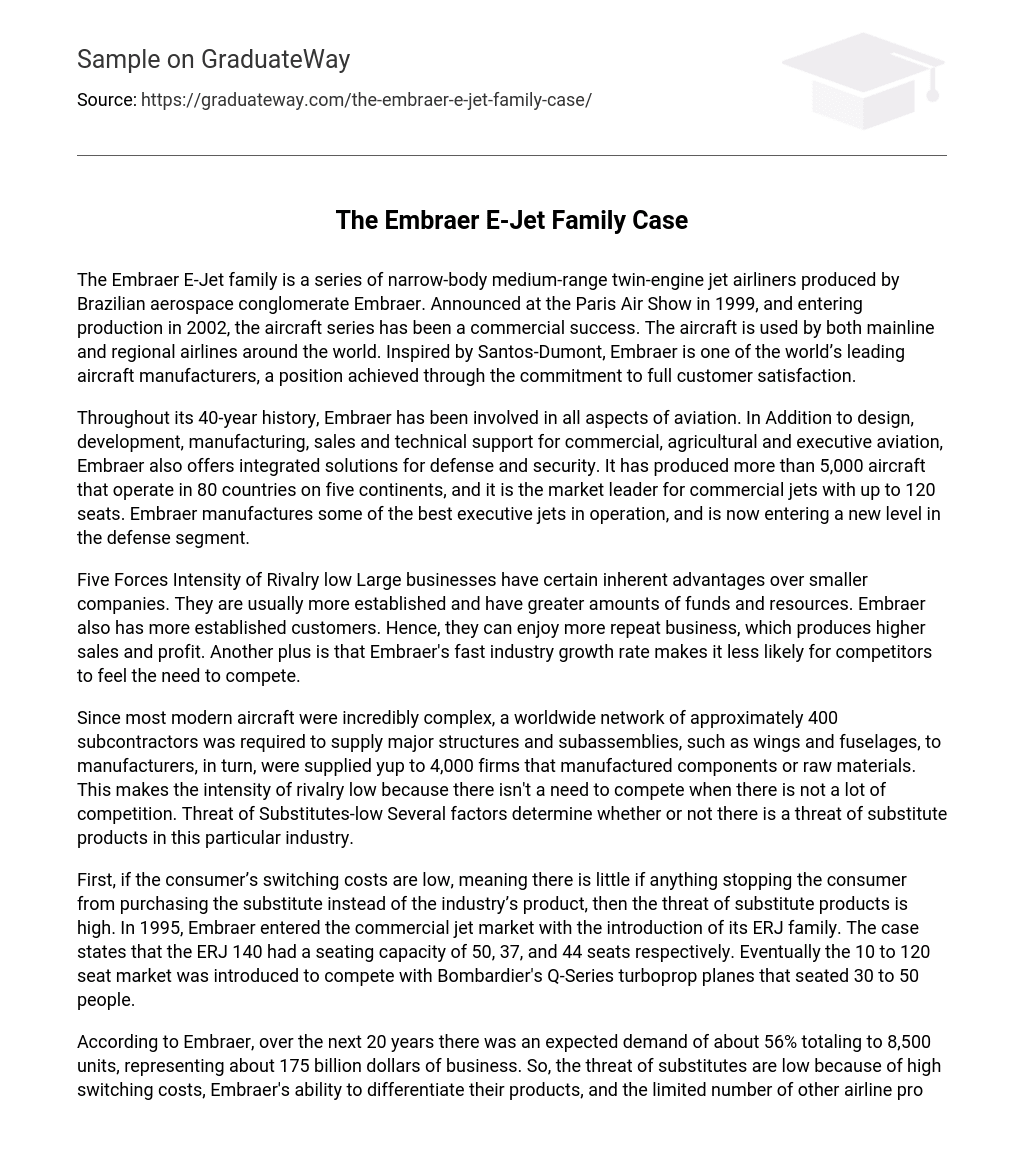The Embraer E-Jet family, which is a series of jet airliners manufactured by the Brazilian aerospace conglomerate Embraer, was introduced at the Paris Air Show in 1999 and went into production in 2002. Since then, these aircrafts have been widely used by both mainline and regional airlines worldwide. Embraer is a well-known aircraft manufacturer that attributes its success to valuing customer satisfaction with inspiration drawn from Santos-Dumont.
Embraer has been involved in all aspects of aviation for 40 years. It specializes in design, development, manufacturing, sales, and technical support for commercial, agricultural, and executive aviation. Additionally, Embraer offers integrated solutions for defense and security.
With a production of over 5,000 aircraft operating in 80 countries on five continents, Embraer is the market leader for commercial jets with up to 120 seats. The company also excels in manufacturing top-quality executive jets and is now expanding its presence in the defense sector.
The intensity of rivalry among competitors is low due to several factors. Large businesses, like Embraer, have inherent advantages over smaller companies. They are more established and have greater funds and resources. Additionally, Embraer has a customer base that is already established, leading to more repeat business and higher sales and profit. Furthermore, the fast industry growth rate of Embraer makes it less likely for competitors to feel the need to compete.
Since most modern aircraft were incredibly complex, they required a worldwide network of approximately 400 subcontractors to supply major structures and subassemblies, such as wings and fuselages, to manufacturers. These manufacturers, in turn, were supplied by up to 4,000 firms that manufactured components or raw materials. This low level of competition makes the intensity of rivalry low. Additionally, several factors determine whether or not there is a threat of substitute products in this particular industry.
If the consumer doesn’t have significant obstacles in purchasing substitute products instead of the industry’s offerings, then the threat of substitute products is high. In 1995, Embraer entered the commercial jet market by launching its ERJ family, which included the ERJ 140 with a seating capacity of 50, 37, and 44 seats respectively. The company later introduced a 10 to 120 seat market to compete against Bombardier’s Q-Series turboprop planes, which accommodated 30 to 50 passengers.
Embarking on the next two decades, Embraer projects a demand of approximately 8,500 units, equivalent to 56%, which would amount to a business value of around 175 billion dollars. Given the high expenses involved in switching to alternative options, Embraer’s capability to set their products apart, and the scarcity of other aviation manufacturers, the threat of substitutes remains negligible. Alongside this, the potential entry of new competitors is rated as low to moderate due to substantial capital prerequisites for market participation. Embraer has consistently introduced groundbreaking concepts that necessitated considerable financial investments for ensuring precision.
Weak distribution networks result in higher transportation costs and the possibility of products not reaching the final customer. As a result, Embraer faces significant sunk costs, which restrict competition. The presence of high sunk costs poses a challenge for potential competitors seeking to enter a new market since they must initially invest money without assurance of future profitability. Additionally, aircraft producers face substantial capital requirements and a need for advanced technologies. The necessity for advanced technologies further complicates entry into the market for new competitors as they must first develop these technologies before effectively competing.
Embraer experiences low to moderate supplier bargaining power because of its diverse distribution channels. The suppliers’ competitive nature could result in price reductions, favoring the producers. Moreover, this situation facilitates producers’ ability to switch suppliers amidst increasing competition. Conversely, customers face a disadvantage in negotiations with sellers due to their limited information.
Buyers need special customization to suit the preferences of all customers. If customers need unique customizations, they are less likely to switch to producers who struggle to meet their requirements. Due to Embraer’s extensive customer base and loyal customers, buyers have less bargaining power. Swot Analysis:
- cost advantage
- High R&D
- Innovative
- loyal customers
- strong brand equity
- strong financial position
- pricing opportunities
- emerging markets and expansion abroad
- online
- developing markets
- takeovers weaknesses -bad communication
– low research and development expenses
– risk management
– weak supply chain threats
– competition
– cheaper technology
– fluctuating exchange rates
– price wars
– World Trade Organization (WTO) sanctions
Strategic Map Recommendations: Embarer should introduce its CSeries aircraft to maintain their lead over their main competitors, Boeing and Airbus. In this industry, innovation is crucial, and both companies are likely to view Embarer’s new jets as a threat to their own jet families. To protect their market position, Embarer should consider merging with Boeing. Together, both companies can dominate the majority of the market share.





